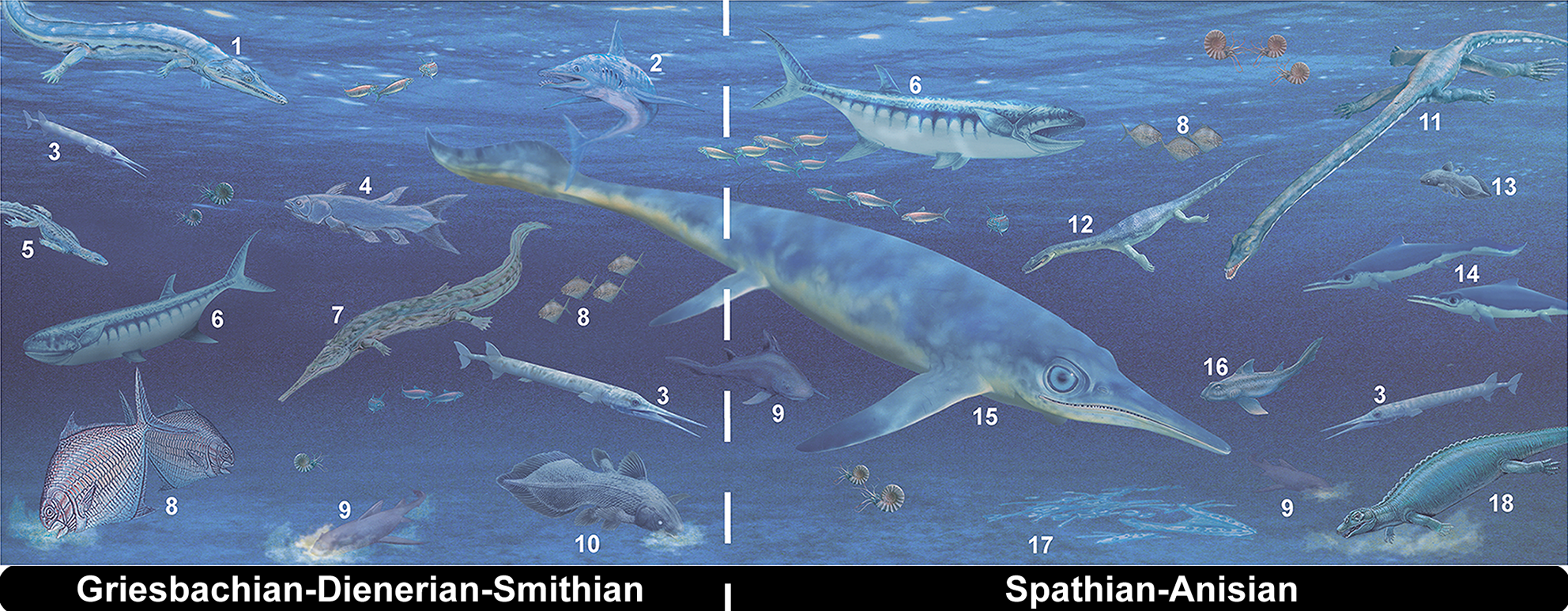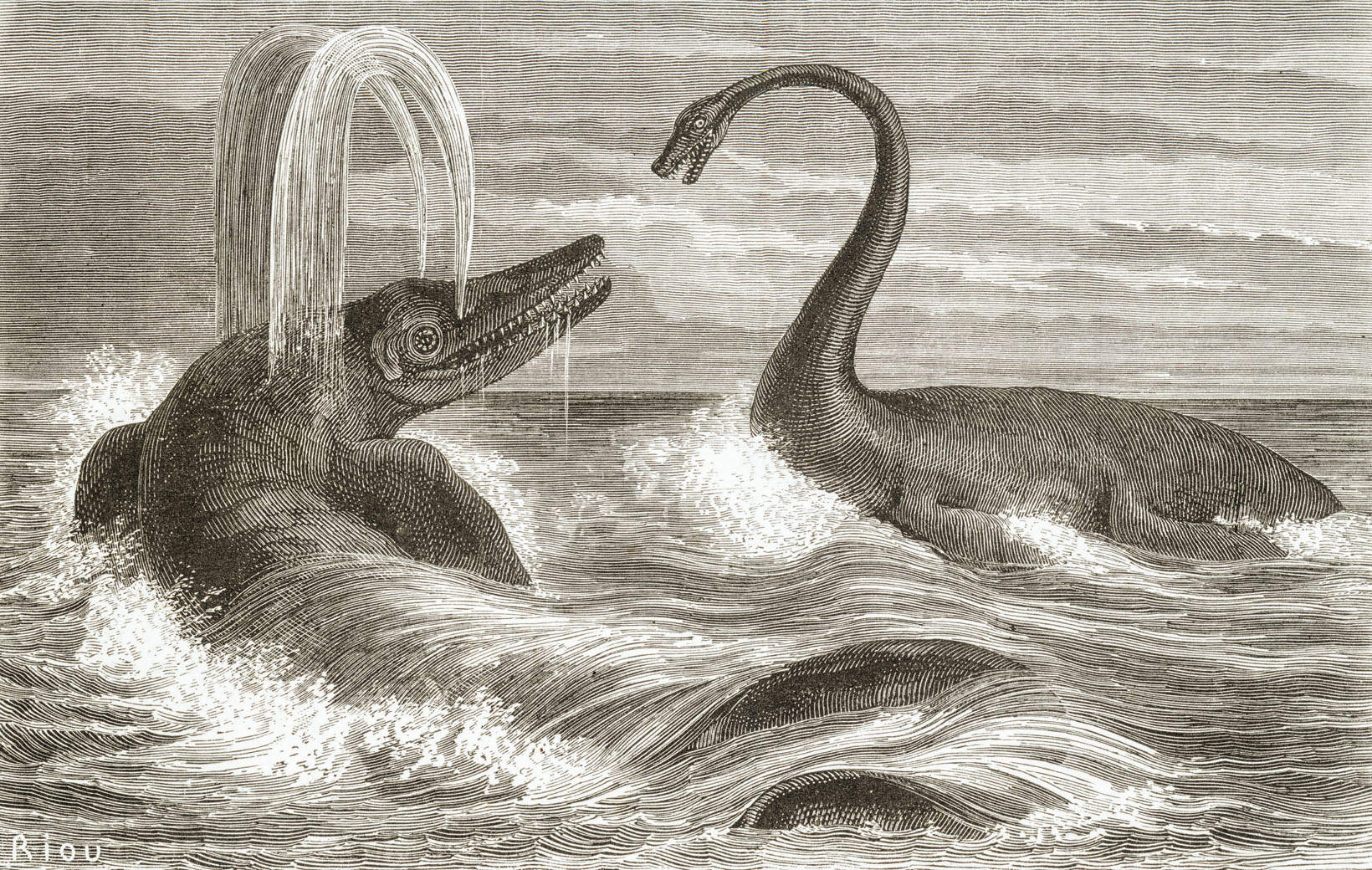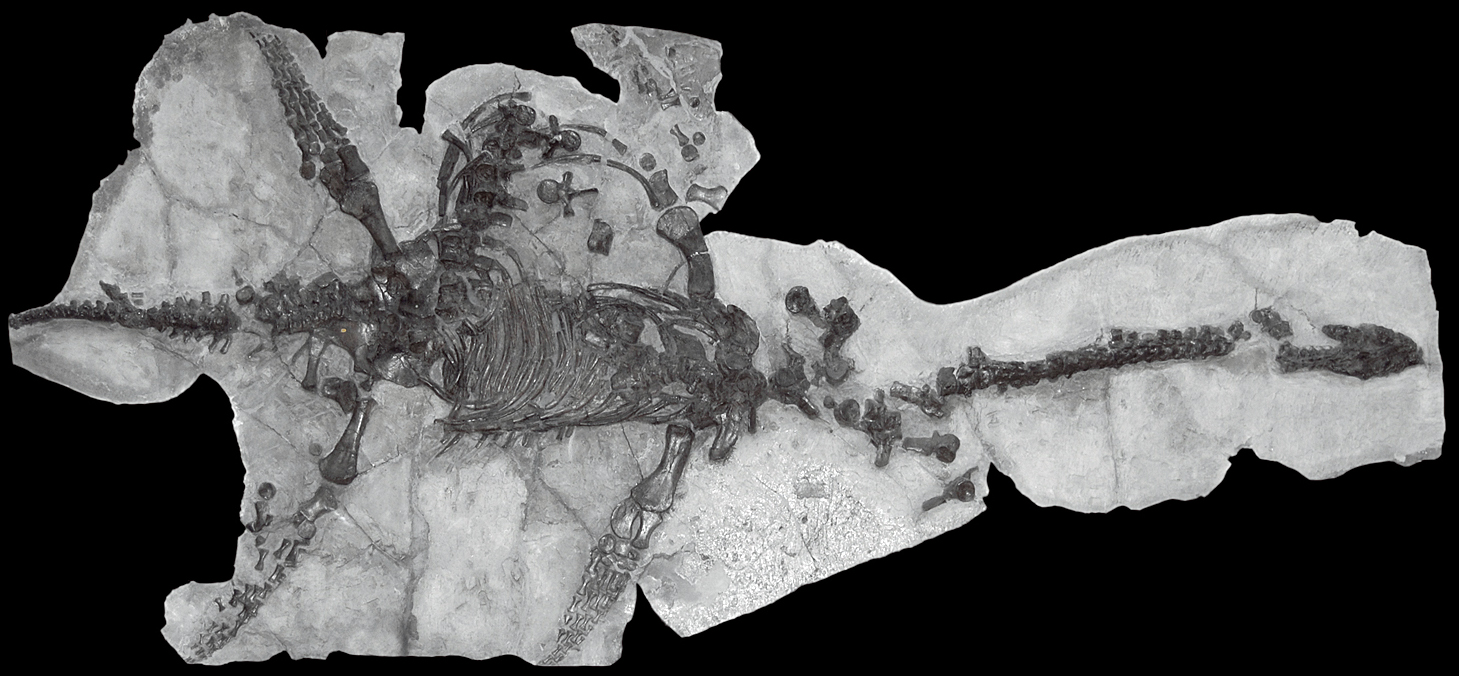|
Omphalosaurus Wolfi
''Omphalosaurus'' (from the Greek root "Button Lizard", for their button-like teeth) is an extinct genus of marine reptile from the Early Triassic to Middle Triassic, thought to be in the order of Ichthyosauria. Most of what is known about ''Omphalosaurus'' is based on multiple jaw fragments, ribs, and vertebrae. Specimens of ''Omphalosaurus'' have been described from the western United States, Poland, Austria and the island of Spitsbergen off the northern coast of Norway. Description ''Omphalosaurus'' is a moderately large and plump marine reptile, measuring long and weighing more than . It is best known for its highly specialized dentition compared to other ichthyosaurs. The teeth are button-like, with a dome shape when viewed laterally and almost circular crowns that have an irregular enamel surface akin to the texture of an orange peel. Individual teeth do not exceed 12mm in diameter and are arranged in tooth plates exclusively on the premaxilla, which sit at 90º from ea ... [...More Info...] [...Related Items...] OR: [Wikipedia] [Google] [Baidu] |
Early Triassic
The Early Triassic is the first of three epochs of the Triassic Period of the geologic timescale. It spans the time between 251.9 Ma and Ma (million years ago). Rocks from this epoch are collectively known as the Lower Triassic Series, which is a unit in chronostratigraphy. The Early Triassic is the oldest epoch of the Mesozoic Era. It is preceded by the Lopingian Epoch (late Permian, Paleozoic Era) and followed by the Middle Triassic Epoch. The Early Triassic is divided into the Induan and Olenekian ages. The Induan is subdivided into the Griesbachian and Dienerian subages and the Olenekian is subdivided into the Smithian and Spathian subages. The Lower Triassic series is coeval with the Scythian Stage, which is today not included in the official timescales but can be found in older literature. In Europe, most of the Lower Triassic is composed of Buntsandstein, a lithostratigraphic unit of continental red beds. The Early Triassic and partly also the Middle Trias ... [...More Info...] [...Related Items...] OR: [Wikipedia] [Google] [Baidu] |
Ammonoidea
Ammonoids are extinct, (typically) coiled-shelled cephalopods comprising the subclass Ammonoidea. They are more closely related to living octopuses, squid, and cuttlefish (which comprise the clade Coleoidea) than they are to nautiluses (family Nautilidae). The earliest ammonoids appeared during the Emsian stage of the Early Devonian (410.62 million years ago), with the last species vanishing during or soon after the Cretaceous–Paleogene extinction event (66 million years ago). They are often called ammonites, which is most frequently used for members of the order Ammonitida, the only remaining group of ammonoids from the Jurassic up until their extinction. Ammonoids exhibited considerable diversity over their evolutionary history, with over 10,000 species having been described. Ammonoids are excellent index fossils, and they have been frequently used to link rock layers in which a particular species or genus is found to specific Geologic time scale, geologic time periods. Their ... [...More Info...] [...Related Items...] OR: [Wikipedia] [Google] [Baidu] |
Olenekian
In the geologic timescale, the Olenekian is an age (geology), age in the Early Triassic epoch (geology), epoch; in chronostratigraphy, it is a stage (stratigraphy), stage in the Lower Triassic series (stratigraphy), series. It spans the time between annum, Ma and Ma (million years ago). The Olenekian is sometimes divided into the Smithian and the Spathian subages or substages. The Olenekian follows the Induan and is followed by the Anisian (Middle Triassic). The Olenekian saw the deposition of a large part of the Buntsandstein in Europe. The Olenekian is roughly coeval with the regional Yongningzhenian Stage used in China. Stratigraphic definitions The Olenekian Stage was introduced into scientific literature by Russian stratigraphers in 1956. The stage is named after Olenëk in Siberia. Before the subdivision in Olenekian and Induan became established, both stages formed the Scythian Stage, which has since disappeared from the official timescale. The base of the Olenekian is ... [...More Info...] [...Related Items...] OR: [Wikipedia] [Google] [Baidu] |
Anisian
In the geologic timescale, the Anisian is the lower stage (stratigraphy), stage or earliest geologic age, age of the Middle Triassic series (stratigraphy), series or geologic epoch, epoch and lasted from million years ago until million years ago. The Anisian Age succeeds the Olenekian Age (part of the Lower Triassic Epoch) and precedes the Ladinian Age. Stratigraphic definitions The stage and its name were established by Austrian geologists Wilhelm Heinrich Waagen and Carl Diener in 1895. The name comes from ''Anisus'', the Latin name of the river Enns (river), Enns. The original type locality (geology), type locality is at Großreifling in the states of Austria, Austrian state of Styria. The base of the Anisian Stage (also the base of the Middle Triassic series) is sometimes laid at the first appearance of conodont species ''Chiosella, Chiosella timorensis'' in the stratigraphic record. Other stratigraphers prefer to use the base of magnetic chronozone MT1n. There is no accept ... [...More Info...] [...Related Items...] OR: [Wikipedia] [Google] [Baidu] |
Humboldt Range
The Humboldt Range is a largely north-south running range of mountains in northwest Nevada, USA, that extend from the town of Imlay in the north to the junction with the West Humboldt Range in the south. It is bordered continuously by Interstate 80 and the Humboldt River The Humboldt River is the longest river in the northern and central part of Nevada. It extends in a general east-to-west direction from its headwaters in northern Nevada's Jarbidge Mountains, Jarbidge, Independence Mountains, Independence, and ..., largely expanded in the form of the Rye Patch Reservoir in this area, on the west side and by a long and fairly broad Buena Vista Valley to the east, in a typical basin-and-range pattern. The Humboldts are ostensibly visible to travelers along Interstate 80, especially with respect to the highest point of the range, Star Peak, which with a quite nicely defined tip reaches an elevation of 9,836 feet (2,998 m), located in the center of the north range section. ... [...More Info...] [...Related Items...] OR: [Wikipedia] [Google] [Baidu] |
Prida Formation
The Prida Formation is a geologic formation in northwestern Nevada. It preserves fossils dating back to the Triassic period. Fossil Hill Member The Prida Formation, along with the Favret Formation, constitute one of the recognized geological formations within the Star Peak Group of northwestern Nevada. These two formations are linked by a single member, known as the Fossil Hill Member. In the Prida Formation, this member outcrops in the western Humboldt Range, while the Favret Formation, outcrops in the Augusta Mountains, where it reaches up to more than 300 metres (980 ft) thick. Although they overlap substantially, the two formations do not share precisely the same age, the Prida unit dates from the Middle to Late Anisian, while the Favret unit dates only from the Late Anisian, between approximately 244 and 242 million years ago. The Fossil Hill Member has received extensive interest from paleontological research for its large quantity of marine fossils dating from the M ... [...More Info...] [...Related Items...] OR: [Wikipedia] [Google] [Baidu] |
Omphalosaurus Jaw Lateral
''Omphalosaurus'' (from the Greek root "Button Lizard", for their button-like teeth) is an extinct genus of marine reptile from the Early Triassic to Middle Triassic, thought to be in the order of Ichthyosauria. Most of what is known about ''Omphalosaurus'' is based on multiple jaw fragments, ribs, and vertebrae. Specimens of ''Omphalosaurus'' have been described from the western United States, Poland, Austria and the island of Spitsbergen off the northern coast of Norway. Description ''Omphalosaurus'' is a moderately large and plump marine reptile, measuring long and weighing more than . It is best known for its highly specialized dentition compared to other ichthyosaurs. The teeth are button-like, with a dome shape when viewed laterally and almost circular crowns that have an irregular enamel surface akin to the texture of an orange peel. Individual teeth do not exceed 12mm in diameter and are arranged in tooth plates exclusively on the premaxilla, which sit at 90º from ea ... [...More Info...] [...Related Items...] OR: [Wikipedia] [Google] [Baidu] |
Bone Tissue
A bone is a Stiffness, rigid Organ (biology), organ that constitutes part of the skeleton in most vertebrate animals. Bones protect the various other organs of the body, produce red blood cell, red and white blood cells, store minerals, provide structure and support for the body, and enable animal locomotion, mobility. Bones come in a variety of shapes and sizes and have complex internal and external structures. They are lightweight yet strong and hard and serve multiple Function (biology), functions. Bone tissue (osseous tissue), which is also called bone in the mass noun, uncountable sense of that word, is hard tissue, a type of specialised connective tissue. It has a honeycomb-like matrix (biology), matrix internally, which helps to give the bone rigidity. Bone tissue is made up of different types of bone cells. Osteoblasts and osteocytes are involved in the formation and mineralization (biology), mineralisation of bone; osteoclasts are involved in the bone resorption, reso ... [...More Info...] [...Related Items...] OR: [Wikipedia] [Google] [Baidu] |
Shastasauridae
Shastasauridae is an extinct family of ichthyosaurs from the Late Triassic with a possible Early Jurassic record. The family contains the largest known species of ichthyosaurs, which include some of and possibly the largest known marine reptiles. Taxonomy Shastasauridae was named by American paleontologist John Campbell Merriam in 1895 along with the newly described genus ''Shastasaurus''. In 1999, Ryosuke Motani erected the clade Shastasauria to include '' Shastasaurus'', '' Shonisaurus'', and several other traditional shastasaurids, defining it as a stem-based taxon including "all merriamosaurians more closely related to '' Shastasaurus pacificus'' than to '' Ichthyosaurus communis''." He also redefined Shastasauridae as a node-based taxon including "the last common ancestor of ''Shastasaurus pacificus'' and '' Besanosaurus leptorhynchus'', and all its descendants" and Shastasaurinae, which Merriam named in 1908, as a stem taxon including "the last common ancestor of ''Shastas ... [...More Info...] [...Related Items...] OR: [Wikipedia] [Google] [Baidu] |
Ichthyosauria
Ichthyosauria is an order of large extinct marine reptiles sometimes referred to as "ichthyosaurs", although the term is also used for wider clades in which the order resides. Ichthyosaurians thrived during much of the Mesozoic era; based on fossil evidence, they first appeared around 250 million years ago ( Ma) and at least one species survived until about 90 million years ago, into the Late Cretaceous. During the Early Triassic epoch, ichthyosaurs and other ichthyosauromorphs evolved from a group of unidentified land reptiles that returned to the sea, in a development similar to how the mammalian land-dwelling ancestors of modern-day dolphins and whales returned to the sea millions of years later, which they gradually came to resemble in a case of convergent evolution. Ichthyosaurians were particularly abundant in the Late Triassic and Early Jurassic periods, until they were replaced as the top aquatic predators by another marine reptilian group, the Plesiosauria, in t ... [...More Info...] [...Related Items...] OR: [Wikipedia] [Google] [Baidu] |
Sauropterygia
Sauropterygia ("lizard flippers") is an extinct taxon of diverse, aquatic diapsid reptiles that developed from terrestrial ancestors soon after the end-Permian extinction and flourished during the Triassic before all except for the Plesiosauria became extinct at the end of that period. The plesiosaurs would continue to diversify until the end of the Mesozoic, when they became extinct as part of the end-Cretaceous mass extinction. Sauropterygians are united by a radical adaptation of their pectoral girdle, adapted to support powerful flipper strokes. Some later sauropterygians, such as the pliosaurs, developed a similar mechanism in their pelvis. Other than being diapsids, their affinities to other reptiles have long been contentious. Sometimes suggested to be closely related to turtles, other proposals have considered them most closely related to Lepidosauromorpha or Archosauromorpha, and/or the marine reptile groups Thalattosauria and Ichthyosauromorpha. Origins an ... [...More Info...] [...Related Items...] OR: [Wikipedia] [Google] [Baidu] |
Synapomorphy
In phylogenetics, an apomorphy (or derived trait) is a novel Phenotypic trait, character or character state that has evolution, evolved from its ancestral form (or Plesiomorphy and symplesiomorphy, plesiomorphy). A synapomorphy is an apomorphy shared by two or more taxon, taxa and is therefore Hypothesis#Scientific hypothesis, hypothesized to have evolved in their most recent common ancestor. ) In cladistics, synapomorphy implies Homology (biology), homology. Examples of apomorphy are the presence of Terrestrial locomotion#Posture, erect gait, fur, Evolution of mammalian auditory ossicles, the evolution of three middle ear bones, and mammary glands in mammals but not in other vertebrate animals such as amphibians or reptiles, which have retained their ancestral traits of a Terrestrial locomotion#Posture, sprawling gait and lack of fur. Thus, these derived traits are also synapomorphies of mammals in general as they are not shared by other vertebrate animals. Etymology The word ... [...More Info...] [...Related Items...] OR: [Wikipedia] [Google] [Baidu] |








